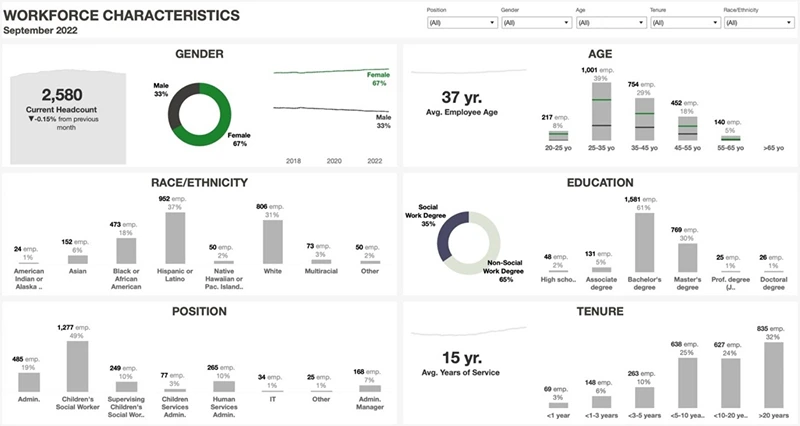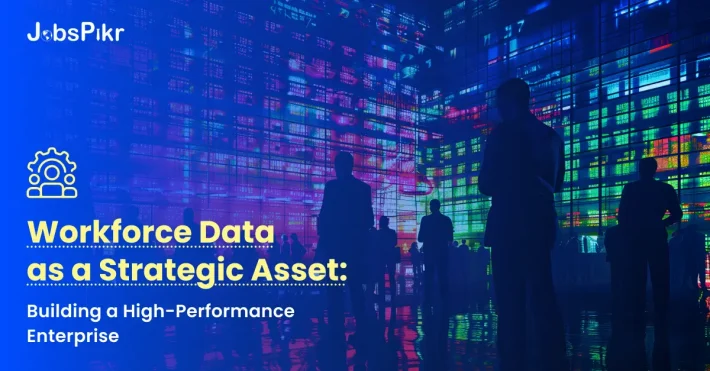- The Evolution of Workforce Data: From Tracking to Predicting
- The Role of Workforce Data in Driving Productivity
- Strategic Cost Control Through Workforce Data Analytics
- Aligning Talent Strategy with Business Goals
- Powering Cross-Functional Planning with Workforce Data
- Improving Internal Mobility and Talent Development
- Using Workforce Data to Strengthen DEI Outcomes
- Real-Time Workforce Data for Agility and Resilience
- Building the Infrastructure: What It Takes to Operationalize Workforce Data
- The Business Case for Workforce Data as an Enterprise Asset
Why Is Workforce Data No Longer Just an HR Metric? For a long time, workforce data was seen as something primarily useful for HR teams. It tracked things like headcount, turnover, and employee satisfaction—but it rarely played a role in bigger business decisions. That’s changing.
In today’s high-speed, data-driven economy, workforce data is no longer just an HR resource. It’s becoming a core strategic asset. Organizations are using it to inform cross-functional decisions—from financial forecasting to operations planning to product innovation. The result? Smarter, more agile enterprises.
In this article, we’ll explore how companies are moving beyond basic reporting and using workforce data analytics to build high-performance teams. We’ll also look at how platforms like JobsPikr are helping organizations treat talent intelligence as business intelligence—improving productivity, controlling costs, and aligning talent strategy with business goals.

Insights how organizations are using workforce data analytics to drive productivity, control costs, and align talent strategy
The Evolution of Workforce Data: From Tracking to Predicting
Traditionally, workforce data focused on what’s already happened. Reports were built to explain past attrition, historical compensation trends, or annual performance reviews. While that’s useful, it doesn’t help much with what’s coming next.
Now, forward-thinking companies are using workforce data analytics to predict, not just track. With the right tools, people analytics teams can now answer critical questions like:
- Which teams are at risk of burnout?
- What skills will we need six months from now?
- Where are our highest-performing employees coming from?
- How long before a high-potential employee leaves if not promoted?
This shift—from descriptive to predictive data—is helping companies stay ahead of workforce challenges instead of reacting too late. A 2024 Deloitte survey found that 72% of enterprise HR leaders consider predictive analytics critical to future success in talent planning.
When workforce data becomes a decision-making tool rather than just a reporting function, it changes how the business operates. Suddenly, HR isn’t just executing plans. It’s shaping them.
The Role of Workforce Data in Driving Productivity
Let’s talk about performance—not at the individual level, but across the organization. What makes a team more productive? Where are resources underutilized? How can you replicate high-performance environments across departments?
The answers lie in the data.
By analyzing patterns in employee engagement, output, collaboration, and even absenteeism, people analytics teams can paint a clear picture of what drives—or slows down—productivity. Workforce data becomes the lens through which inefficiencies are identified and addressed.
For example, data might show that teams with regular cross-functional check-ins deliver faster project turnarounds. Or that departments with low manager-to-employee ratios have higher satisfaction scores and lower churn. These insights enable leaders to create high-performance environments by design, not by accident.
This kind of data driven workforce planning ensures that the workforce isn’t just busy—it’s aligned and efficient.
Strategic Cost Control Through Workforce Data Analytics
Workforce costs often represent a company’s largest operating expense. But understanding those costs in detail—who’s being paid what, for what roles, and with what return—is surprisingly hard without robust data systems.

Workforce data analytics offers a clearer view. With the right insights, organizations can:
- Identify departments that are overstaffed or underutilized
- Highlight roles where compensation is not aligned with market benchmarks
- Forecast the cost of talent shortages in mission-critical roles
- Model the financial impact of hybrid vs. on-site staffing structures
When cost control is driven by data rather than top-down cuts, it leads to smarter, more sustainable decisions. Rather than slashing budgets across the board, businesses can target inefficiencies while protecting high-value talent investments.
JobsPikr supports this process by providing labor market intelligence and benchmarking tools. These help businesses compare internal workforce spending with external trends—making workforce planning more informed, contextual, and strategic.
Aligning Talent Strategy with Business Goals
One of the most powerful uses of workforce data is aligning HR and business strategy. Too often, talent plans are made in isolation—HR teams focus on headcount, while business leaders focus on revenue, product delivery, or expansion.
But when workforce data is integrated into strategic planning, everything changes.
Here’s how:
- HR can forecast workforce needs based on product roadmaps or growth projections
- Finance can model the impact of hiring surges or turnover on revenue timelines
- Operations can align resource planning with talent availability
This kind of coordination only happens when everyone is working from the same source of truth. And that truth is rooted in data.
A McKinsey study found that companies that actively align talent strategy with business goals are 2.2 times more likely to outperform their peers financially. Workforce data analytics makes that alignment possible—and measurable.
Powering Cross-Functional Planning with Workforce Data
Workforce data doesn’t live in a silo anymore—and neither does workforce strategy.
Departments across the business—from IT and finance to operations and customer success are now relying on people’s insights to plan better. For example:
- IT teams use data to plan onboarding and equipment needs
- Finance teams use workforce forecasts for budget modeling
- Legal and compliance teams track contractor usage and workforce risk
- Customer success teams analyze service load per employee to scale teams correctly
This is the future of data driven workforce planning: connecting the dots between talent decisions and business outcomes. And it’s only possible when workforce data is centralized, accessible, and actionable across functions.
That’s where platforms like JobsPikr come in. With integrations that allow cross-functional teams to access job market trends, hiring forecasts, and internal workforce intelligence, JobsPikr helps organizations build a more connected planning ecosystem.
Improving Internal Mobility and Talent Development
Retaining top talent is just as important as acquiring it. But without clear data on employee skills, aspirations, and growth potential, companies risk missing opportunities to promote from within.
Workforce data plays a big role in mapping internal mobility. It helps HR teams answer questions like:
- Which employees are ready for new challenges?
- Who has leadership potential?
- What learning paths have led to career advancement in the past?
- Where do we have skill surpluses or gaps?
By using data to guide development, companies can build personalized career paths that increase engagement and reduce turnover. Employees who feel seen and supported are far more likely to stay—and contribute more deeply.
Workforce data also supports more equitable talent development. By tracking promotion rates across demographics, companies can uncover gaps and take action to ensure fairness.
Using Workforce Data to Strengthen DEI Outcomes
Diversity, equity, and inclusion are priorities for most modern enterprises. But achieving meaningful outcomes requires more than intent—it requires measurement.
Workforce data analytics allows organizations to track:
- Representation across levels, departments, and geographies
- Pay equity gaps and progression disparities
- Inclusion sentiment through engagement surveys
- Hiring pipeline diversity and attrition trends
With these insights, companies can take targeted actions to improve DEI outcomes—whether it’s rethinking recruitment practices, providing targeted leadership development, or auditing pay structures.
And because data is trackable over time, it helps organizations move from pledges to progress. JobsPikr’s workforce intelligence includes location-based diversity data, enabling companies to set realistic goals based on talent market benchmarks.

Real-Time Workforce Data for Agility and Resilience
In unpredictable times—whether due to economic shifts, global events, or technological disruption—organizations need to pivot fast. That agility depends on having access to real-time workforce insights.
Companies with strong workforce data capabilities are better equipped to:
- Respond to sudden changes in talent supply or demand
- Reallocate resources quickly based on business priorities
- Adjust workforce models (remote, hybrid, contract) with minimal friction
- Maintain productivity even during restructuring or transformation
Real-time visibility is the difference between guessing and knowing. And in a world where delay can cost millions, knowledge is everything.
JobsPikr’s real-time labor market data, coupled with internal workforce dashboards, gives companies the responsiveness they need to act fast and smart.

Building the Infrastructure: What It Takes to Operationalize Workforce Data
Turning workforce data into a strategic asset doesn’t happen overnight. It requires a shift in mindset, tools, and process.
Key steps include:
- Centralizing data sources: Bring together HRIS, ATS, learning, and engagement data into one system.
- Creating consistent definitions: Ensure everyone understands what “high potential,” “regrettable attrition,” or “bench strength” actually mean.
- Investing in analytics tools: Use platforms that go beyond reporting and offer predictive and prescriptive insights.
- Training teams to interpret data: Analytics only works when decision-makers know how to use it.
Culture also plays a role. Organizations that treat workforce data as strategic are the ones that make it part of every major decision—not just annual reviews or budget cycles.
The Business Case for Workforce Data as an Enterprise Asset
In a world where every business decision must be faster, sharper, and more informed, workforce data has evolved from a reporting tool into a strategic powerhouse. It’s not just about tracking employee numbers or logging attrition—it’s about using data to shape growth, anticipate change, and create a workforce that’s agile, aligned, and ready for what’s next.
By treating workforce data as a strategic asset, enterprises can:
- Improve operational efficiency by understanding how talent drives output
- Make smarter hiring and retention decisions through predictive insights
- Create equitable, inclusive workplaces grounded in measurable progress
- Align workforce planning with long-term business goals
When workforce intelligence becomes part of everyday decision-making, organizations move beyond reactive HR and step into proactive business leadership.If you’re ready to transform your approach to workforce planning and analytics, sign up on JobsPikr. Gain access to real-time labor market insights, predictive analytics, and the tools you need to build a high-performance workforce—backed by data that works as hard as your team does.




